The Deep Sea Robot Market is estimated to be valued at USD 3.2 billion in 2025 and is projected to reach USD 10.6 billion by 2035, registering a compound annual growth rate (CAGR) of 12.8% over the forecast period.
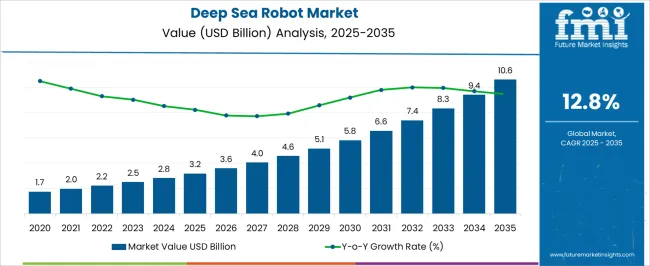
| Metric | Value |
|---|---|
| Deep Sea Robot Market Estimated Value in (2025 E) | USD 3.2 billion |
| Deep Sea Robot Market Forecast Value in (2035 F) | USD 10.6 billion |
| Forecast CAGR (2025 to 2035) | 12.8% |
The Deep Sea Robot market is witnessing steady growth as advancements in underwater exploration and industrial automation drive demand for intelligent, software-enabled robotic systems. The current market environment reflects increasing adoption in sectors such as offshore oil and gas, marine research, environmental monitoring, and deep ocean resource exploration. Growth is being supported by the ability of these robots to operate at extreme depths, perform complex tasks with high precision, and integrate with advanced control systems.
The market outlook is influenced by the rising need for cost-effective and safe alternatives to human divers in hazardous underwater conditions. Technological improvements in sensor integration, navigation systems, and autonomous operational software are enhancing the efficiency and reliability of deep sea robots.
In addition, expanding research initiatives and investment in oceanic infrastructure are opening new applications for these robotic systems As global interest in deep ocean exploration, subsea energy extraction, and environmental monitoring continues to grow, the Deep Sea Robot market is expected to maintain strong momentum, driven by solutions that combine high functional capability with robust operational performance.
The deep sea robot market is segmented by type, functional ability, and geographic regions. By type, deep sea robot market is divided into Remotely Operate Vehicles (ROVs), Submersibles, Autonomous Underwater Vehicles (AUVs), and Others. In terms of functional ability, deep sea robot market is classified into Task Performance, Self-Maintenance, Task Perception, Environmental Perception, Autonomous Navigation, and Other Abilities (Self-Learning, Reasoning, Etc.). Regionally, the deep sea robot industry is classified into North America, Latin America, Western Europe, Eastern Europe, Balkan & Baltic Countries, Russia & Belarus, Central Asia, East Asia, South Asia & Pacific, and the Middle East & Africa.
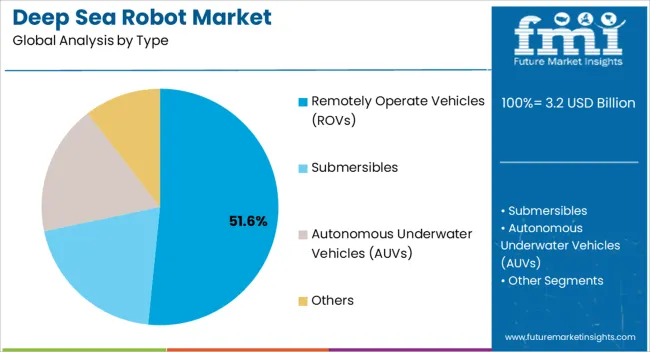
The Remotely Operated Vehicles segment is projected to hold 51.60% of the Deep Sea Robot market revenue share in 2025, positioning it as the leading type in the market. This dominance is being attributed to its ability to perform highly complex underwater operations under remote supervision, allowing precision control in environments where human access is limited or unsafe.
The widespread adoption of remotely operated vehicles has been reinforced by industries requiring high reliability, including subsea oil and gas exploration, underwater infrastructure inspection, and scientific research. Operational flexibility, modular design, and compatibility with multiple sensor systems have contributed to faster deployment and broader applicability.
The capacity to conduct real-time data acquisition and analysis, coupled with high maneuverability in challenging underwater terrains, has further enhanced the attractiveness of this type As underwater missions become increasingly sophisticated, the demand for remotely operated vehicles is expected to remain strong, supported by technological advancements in navigation, propulsion, and remote control systems.
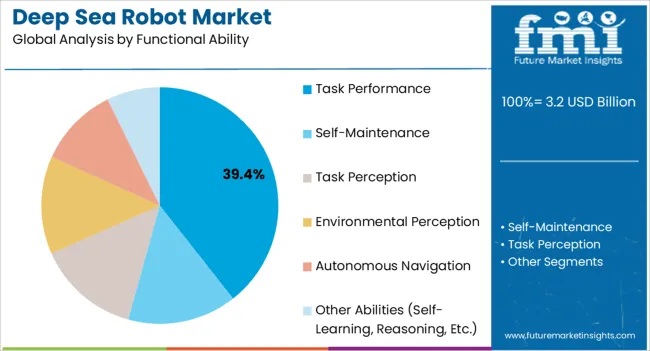
The Task Performance functional ability segment is anticipated to account for 39.40% of the Deep Sea Robot market revenue in 2025, making it a leading capability in the market. This prominence is being driven by the growing requirement for robots to execute precise and complex operations autonomously or under minimal supervision.
Task performance functionality is critical in sectors such as subsea construction, salvage operations, environmental monitoring, and scientific exploration, where repetitive or high-risk activities must be executed with accuracy. The growth of this segment has been facilitated by advances in AI-based operational algorithms, enhanced sensor systems, and automated manipulation technologies that improve efficiency and reduce the need for human intervention.
Furthermore, the ability to integrate task performance capabilities into various robot types without extensive hardware changes has made this segment highly adaptable As industries continue to prioritize operational efficiency, safety, and cost reduction, the demand for deep sea robots with advanced task performance capabilities is expected to grow steadily, reinforcing this functional ability as a key revenue contributor in the market.
Before innovations in the field of deep sea robotics, scientists and researchers depended upon an analogue methodology to collect information regarding the deep sea. They used to send Niskin bottles and nets deep down into the sea to collect water and animal samples respectively. The development of deep sea robots enabled scientists and researchers to cover more ground, and innovations in the field have revolutionised the method of exploring the deep sea.
In the deep sea robotics field, Autonomous Underwater Vehicles (AUVs) are used to map deep reefs and explore the life under water. Remotely operable deep sea robots are deployed under water to enable scientists to discover, study and classify new species. Through deep sea robots, scientists have discovered that different species of aquatic animals live at different depths of oceans as well as seas. At present, scientists and research organisations are collaborating with various industries to use deep sea robots for the purpose of monitoring deep sea oil rigs.
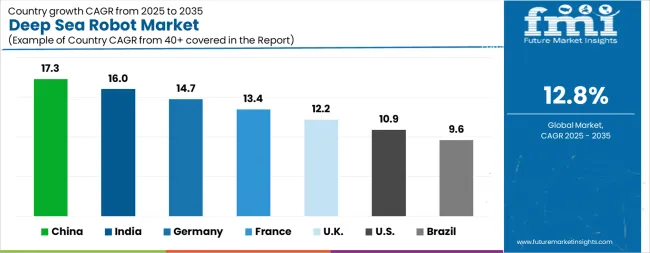
| Country | CAGR |
|---|---|
| China | 17.3% |
| India | 16.0% |
| Germany | 14.7% |
| France | 13.4% |
| UK | 12.2% |
| USA | 10.9% |
| Brazil | 9.6% |
The Deep Sea Robot Market is expected to register a CAGR of 12.8% during the forecast period, exhibiting varied country level momentum. China leads with the highest CAGR of 17.3%, followed by India at 16.0%. Developed markets such as Germany, France, and the UK continue to expand steadily, while the USA is likely to grow at consistent rates. Brazil posts the lowest CAGR at 9.6%, yet still underscores a broadly positive trajectory for the global Deep Sea Robot Market. In 2024, Germany held a dominant revenue in the Western Europe market and is expected to grow with a CAGR of 14.7%. The USA Deep Sea Robot Market is estimated to be valued at USD 1.2 billion in 2025 and is anticipated to reach a valuation of USD 3.2 billion by 2035. Sales are projected to rise at a CAGR of 10.9% over the forecast period between 2025 and 2035. While Japan and South Korea markets are estimated to be valued at USD 158.7 million and USD 91.8 million respectively in 2025.
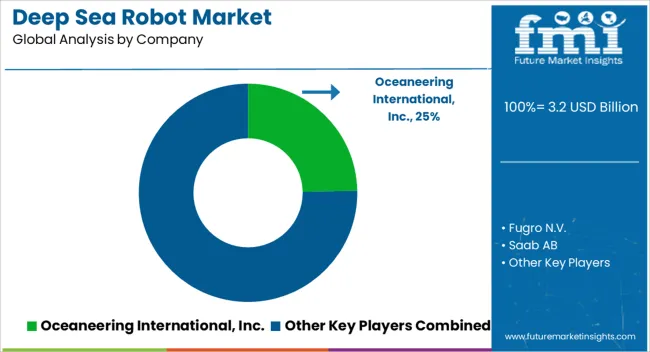
| Item | Value |
|---|---|
| Quantitative Units | USD 3.2 Billion |
| Type | Remotely Operate Vehicles (ROVs), Submersibles, Autonomous Underwater Vehicles (AUVs), and Others |
| Functional Ability | Task Performance, Self-Maintenance, Task Perception, Environmental Perception, Autonomous Navigation, and Other Abilities (Self-Learning, Reasoning, Etc.) |
| Regions Covered | North America, Europe, Asia-Pacific, Latin America, Middle East & Africa |
| Country Covered | United States, Canada, Germany, France, United Kingdom, China, Japan, India, Brazil, South Africa |
| Key Companies Profiled | Oceaneering International, Inc., Fugro N.V., Saab AB, Teledyne Marine, Kongsberg Maritime, Bluefin Robotics, Atlas Elektronik GmbH, Soil Machine Dynamics (SMD), and Subsea 7 |
The global deep sea robot market is estimated to be valued at USD 3.2 billion in 2025.
The market size for the deep sea robot market is projected to reach USD 10.6 billion by 2035.
The deep sea robot market is expected to grow at a 12.8% CAGR between 2025 and 2035.
The key product types in deep sea robot market are remotely operate vehicles (rovs), submersibles, autonomous underwater vehicles (auvs) and others.
In terms of functional ability, task performance segment to command 39.4% share in the deep sea robot market in 2025.






Our Research Products

The "Full Research Suite" delivers actionable market intel, deep dives on markets or technologies, so clients act faster, cut risk, and unlock growth.

The Leaderboard benchmarks and ranks top vendors, classifying them as Established Leaders, Leading Challengers, or Disruptors & Challengers.

Locates where complements amplify value and substitutes erode it, forecasting net impact by horizon

We deliver granular, decision-grade intel: market sizing, 5-year forecasts, pricing, adoption, usage, revenue, and operational KPIs—plus competitor tracking, regulation, and value chains—across 60 countries broadly.

Spot the shifts before they hit your P&L. We track inflection points, adoption curves, pricing moves, and ecosystem plays to show where demand is heading, why it is changing, and what to do next across high-growth markets and disruptive tech

Real-time reads of user behavior. We track shifting priorities, perceptions of today’s and next-gen services, and provider experience, then pace how fast tech moves from trial to adoption, blending buyer, consumer, and channel inputs with social signals (#WhySwitch, #UX).

Partner with our analyst team to build a custom report designed around your business priorities. From analysing market trends to assessing competitors or crafting bespoke datasets, we tailor insights to your needs.
Supplier Intelligence
Discovery & Profiling
Capacity & Footprint
Performance & Risk
Compliance & Governance
Commercial Readiness
Who Supplies Whom
Scorecards & Shortlists
Playbooks & Docs
Category Intelligence
Definition & Scope
Demand & Use Cases
Cost Drivers
Market Structure
Supply Chain Map
Trade & Policy
Operating Norms
Deliverables
Buyer Intelligence
Account Basics
Spend & Scope
Procurement Model
Vendor Requirements
Terms & Policies
Entry Strategy
Pain Points & Triggers
Outputs
Pricing Analysis
Benchmarks
Trends
Should-Cost
Indexation
Landed Cost
Commercial Terms
Deliverables
Brand Analysis
Positioning & Value Prop
Share & Presence
Customer Evidence
Go-to-Market
Digital & Reputation
Compliance & Trust
KPIs & Gaps
Outputs
Full Research Suite comprises of:
Market outlook & trends analysis
Interviews & case studies
Strategic recommendations
Vendor profiles & capabilities analysis
5-year forecasts
8 regions and 60+ country-level data splits
Market segment data splits
12 months of continuous data updates
DELIVERED AS:
PDF EXCEL ONLINE
Deep Depth Subsea Umbilicals, Risers and Flowlines Market Size and Share Forecast Outlook 2025 to 2035
Seatbelt Polyester Yarn Market Size and Share Forecast Outlook 2025 to 2035
Seawater Source Heat Pump System Market Size and Share Forecast Outlook 2025 to 2035
Seabed Crawler Market Size and Share Forecast Outlook 2025 to 2035
Seasoning Filling System Market Size and Share Forecast Outlook 2025 to 2035
Seat Control Module (SCM) Market Forecast and Outlook 2025 to 2035
Seafood Farming Chillers Market Forecast and Outlook 2025 to 2035
Sealing & Strapping Packaging Tape Market Size and Share Forecast Outlook 2025 to 2035
Robot Controller, Integrator and Software Market Size and Share Forecast Outlook 2025 to 2035
Search and Rescue Equipment (SAR) Market Size and Share Forecast Outlook 2025 to 2035
Deep Brain Stimulator Market Size and Share Forecast Outlook 2025 to 2035
Robotic Warfare Market Size and Share Forecast Outlook 2025 to 2035
Robotic Lawn Mower Market Size and Share Forecast Outlook 2025 to 2035
Deep Packet Inspection And Processing Market Size and Share Forecast Outlook 2025 to 2035
Robotics Welding Market Size and Share Forecast Outlook 2025 to 2035
Seaport Security Management Market Size and Share Forecast Outlook 2025 to 2035
Robotic Rehab Tools Market Analysis - Size, Share, and Forecast Outlook 2025 to 2035
Seaweed Extracts Market Size and Share Forecast Outlook 2025 to 2035
Robotics-Assisted Telesurgery Market Size and Share Forecast Outlook 2025 to 2035
Robotic Packaging Machines Market Size and Share Forecast Outlook 2025 to 2035

Thank you!
You will receive an email from our Business Development Manager. Please be sure to check your SPAM/JUNK folder too.
Chat With
MaRIA